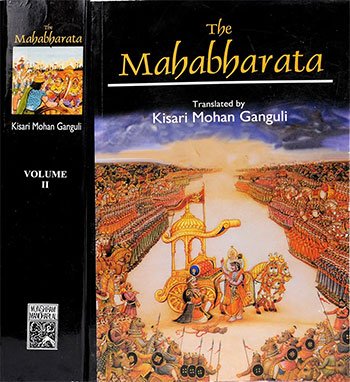Section II - The Battle of Kurukshetra: Vyasa's Prediction and Omens
Book index: Mahabharata (English)
This page contains a summary of the Mahabharata Section II including examples of moral lessons in daily life. The Maha-Bharata is one of the largest epics ever written containing roughly 100,000 Sanskrit verses. It deals with the legendary history of ancient India and contains a large number of interwoven tales.
Short summary of the chapter:
The holy Rishi Vyasa informs King Dhritarashtra that a fierce battle is imminent between his sons and other monarchs, and that they will all perish as their hour has come. Dhritarashtra expresses his reluctance to witness the slaughter of his kinsmen, but Vyasa grants him the power to hear about the battle through the celestial vision of Sanjaya. Vyasa assures Dhritarashtra that Sanjaya will have knowledge of everything happening in the battle, both manifest and concealed, and that he will narrate it in full detail. He also warns of impending omens of terror, such as birds gathering, celestial phenomena, and strange occurrences in the sky, foretelling a great slaughter.
Vyasa describes various omens he has observed, such as carnivorous birds and beasts gathering, tri-colored clouds enveloping the sun, and celestial bodies displaying unusual signs, indicating fear and destruction. He mentions signs like the moon turning invisible or fiery, and images of gods and goddesses behaving strangely, along with odd sounds and sights in nature. Unusual behaviors of animals, insects, and celestial bodies are reported, along with terrifying cries and movements of armored soldiers and chariots without animals yoked to them. These omens portend a great calamity and widespread destruction in the impending battle.
Vyasa continues to list various signs of impending doom, such as drums giving sounds without being beaten, celestial quarters appearing ablaze, and clouds raining dust and flesh. He mentions the distress of animals, with insects weeping, and tears falling from their eyes, along with the unusual positions of constellations and planets. Vyasa notes the alignment of stars and planets indicating affliction and terror, as well as the weeping of animals and the roaring heard in the sky. These signs collectively point towards a massive and catastrophic event about to unfold in the imminent battle.
In conclusion, Vyasa's warnings and descriptions of ominous signs paint a vivid picture of the impending battle's devastation and tragedy, foreshadowing the inevitable slaughter and destruction that will occur. Dhritarashtra is urged not to give in to grief and to accept destiny, as victory lies where righteousness is upheld. The stage is set for a great and terrible battle that will result in the loss of many noble and brave warriors, as foreseen by the wise and insightful Rishi Vyasa. The events that will unfold are beyond human control, driven by fate and the inevitable consequences of war.
Full English translation:
This page is merely a summary which is automatically generated. If you are looking for authentic sources such as the Sanskrit text or the Full English translation of Mahabharata Section II - The Battle of Kurukshetra: Vyasa's Prediction and Omens, have a look at the following articles:
Section II, online text
English translation by Kisari Mohan Ganguli.
Read this and other chapters online.
Mahabharata (English Summary)
by Kisari Mohan Ganguli | ISBN-10: 8121505933
Buy the latest edition:
FAQ of Mahabharata, Section II:
What ominous signs were foreseen before the battle by Vyasa?
Vyasa saw birds gathering, strange phenomena in the sky, and celestial omens.
Why did Dhritarashtra not want to see the battle?
Dhritarashtra did not wish to witness the slaughter of his kinsmen.
Who did Vyasa grant the power to describe the battle to Dhritarashtra?
Vyasa granted Sanjaya celestial vision to describe the battle accurately.
Daily life: The Battle of Kurukshetra: Vyasa's Prediction and Omens:
The story speaks about accepting the inevitable changes and challenges of life, as highlighted by the wise sage Vyasa, who counsels King Dhritarashtra to embrace the reality of the impending battle and the consequences it will bring to his family and realm. Vyasa's wisdom teaches us the importance of acknowledging destiny and the uncontrollable nature of certain events, guiding us to not succumb to despair in the face of adversity. Instead, we are encouraged to find a way to navigate through our troubles without letting grief overwhelm our hearts.
In applying this to daily life, it means understanding that life will present us with difficult times and challenges that seem insurmountable. However, just as Vyasa offered the king a way to stay informed about the battle without directly witnessing its horrors, we too can find methods to manage and cope with our problems in a manner that is least harmful to ourselves and those around us. Acceptance of what we cannot change, seeking support in our darkest hours, and finding ways to stay resilient are crucial lessons drawn from the narrative. It reminds us that even though we cannot always control what happens to us, we can control how we respond to it, ensuring that we do not let sorrow define our lives.
